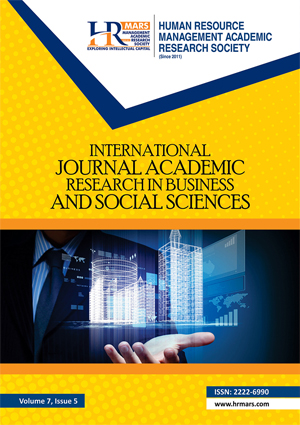
ISSN: 2222-6990
Open access
Bugis are one of Malaysia's minority communities. Bugis communities use loanwords as a way of ensuring smooth communication. While the Bugis community tries to absorb all Malay loanwords into the Bugis language, a phonological process prevents the Malay lexicon from being fully absorbed. This process is called the glottal stop /?/. The fieldwork was conducted at two places in Johore state: Pontian and Pasir Gudang. The fieldwork was also conducted in the Selangor state at Pandamaran, Klang. A questionnaire containing a section on the informant's background and a word list was prepared for the interview session with 200 Bugis respondents. By using the Output-Output correspondent in Optimality theory, this study will address some of the emerging issues; Firstly, what is the intent of using glottal stop /?/ strategy in the Bugis language loanwords adaptation? Secondly, what constraints are used in the glottal stop /?/ strategy in the Bugis-language loanwords adaptation using Optimality theory (OT) and OO-Correspondence (OO-Cor). The study shows that there are two main reasons why a glottal stop occurs, firstly, as a syllable closure and secondly, as a consonant substitution. Based on TO and OO-Cor analysis, Malay loanwords must comply with *IDENTICAL LEXICAL constraint of production output in Bugis language. The results of this study have contributed to the development of the Bugis language study from a linguistic point of view using Optimality and Correspondence-OO theory.
Baugh, A. C., and Cable, T. (1993). A History of the English Language.Englewood Cliffs, N. J.: Prentice-Hall.
Benua, L. (1995). Indentity Effects in Morphological Truncation. The University of Massachusetts Occasional Papers in Linguistics 18: Papers in Optimality Theory.
Brown, K., & Miller, J. (2013). The Cambridge dictionary of linguistics. UK: Cambridge Universiti Press.
Chang, C. B. (2003). "High-interest loans": The phonology of English loanword adaptation in Burmese (Doctoral dissertation, Harvard University).
Fattah, A., Afkari, R., Rusdi, M., & Abdullah, M. (2011). Penghijrahan Masyarakat Bugis Ke Alam Melayu: Kajian Kes Bugis Di Indragiri Hilir Riau.
Ferreira, M. (2004). Diminutives in Brazilian Portuguese and Output-Output correspondence. 34th Linguistics Series. London: Routledge.
Garellek, M. (2013). Production and perception of glottal stops (Doctoral dissertation, UCLA).
Harun, M. H., KATUTU, B., & Yahya, S. R. (2013). Diaspora Bugis Di Sumatra. Tanjong Malim. Fakulti Bahasa dan Komunikasi Universiti Pendidikan Sultan Idris (UPSI).
Heigham, J., & Croker, R. (Eds.). 2009. Qualitative research in applied linguistics: A practical introduction. Springer.
Jacobs, H., & Gussenhoven, C. (2000). Loan Phonology: Perception. Optimality Theory: Phonology, syntax, and acquisition, 193.
Kager, R. (1999). Optimality Theory. New York: Cambridge University Press.
Macknight, C. C. (Ed.). (2012). Bugis and Makasar: two short grammars. Karuda Press.
Mccarthy, J. J., & Prince, A. S. (1993). Prosodic Morphology ?: Constraint Interaction and Satisfaction. Massachusetts: MIT Press.
Mccarthy, J. J., & Prince, A. S. (1994). The Emergence of The Unmarked: Optimality in Prosodic Morphology. Proceeding of NELS 24: 333-379.
Mccarthy, J. J., & Prince, A. S. (1994). The Emergence of The Unmarked: Optimality in Prosodic Morphology. Proceeding of NELS 24: 333-379.
Mccarthy, J. J., & Prince, A. S. (1995). Faithfulness and Reduplicative Identity. The University of Massachusetts Occasional Papers in Linguistics UMOP 18: 249-38.
Mccarthy, J. J. (2002). A thematic Guide to Optimality Theory. Cambridge: Cambridge University Press.
McCrum, R., Cran, W., MacNeil, R., & MacNeil, R. (1986). The story of English (p. 267). London: Faber & Faber.
Omar, R., Tamrin, K. M., & Hussin, N. (2009). Sejarah Kedatangan Masyarakat Bugis ke Tanah Melayu: Kajian Kes di Johor. JEBAT: Malaysian Journal of History, Politics & Strategic Studies, 36, 41-61.
Prince, A. M., and Smolensky, P. (1993). Optimality Theory: Contrain Interaction in Generative Grammar.
Rusdiansyah, R., & Retty, I. (2018). Language Attitudes Of Buginese Speakers In Bandung. Ideas: Journal on English Language Teaching and Learning, Linguistics and Literature, 6(2).
Smith, J. L. (2006). Loan Phonology is Not All Perception: Evidence from Japanese Loan Doublets. Japanese/Korean Linguistics Volume 14: 63-74.
Somers, H. (1997). Machine translation and minority languages. Translating and the Computer, 13-13.
Tachimoto, N. M. (1994). Coping with the Currents of Change. Japanese Journal of Southeast Asian Studies, 32(2), 197-230.
Thomason, S. G. (2001). Language Contact. Edinburg: Edinburgh University Press.
Yip, M. (1993). Cantonese Loanword Phonology and Optimality Theory. Journal of East Asian Linguistics 2: 261-91.
In-Text Citation: (Sah & Jaafar, 2023)
To Cite this Article: Sah, M. F. M., & Jaafar, S. R. S. (2023). Glottal Stop /?/ Strategy in Adaptation of Malay Loanwords in Bugis Language based on Output-Output Correspondent Analysis. International Journal of Academic Research in Business and Social Sciences, 13(4), 357 – 368.
Copyright: © 2023 The Author(s)
Published by HRMARS (www.hrmars.com)
This article is published under the Creative Commons Attribution (CC BY 4.0) license. Anyone may reproduce, distribute, translate and create derivative works of this article (for both commercial and non-commercial purposes), subject to full attribution to the original publication and authors. The full terms of this license may be seen at: http://creativecommons.org/licences/by/4.0/legalcode